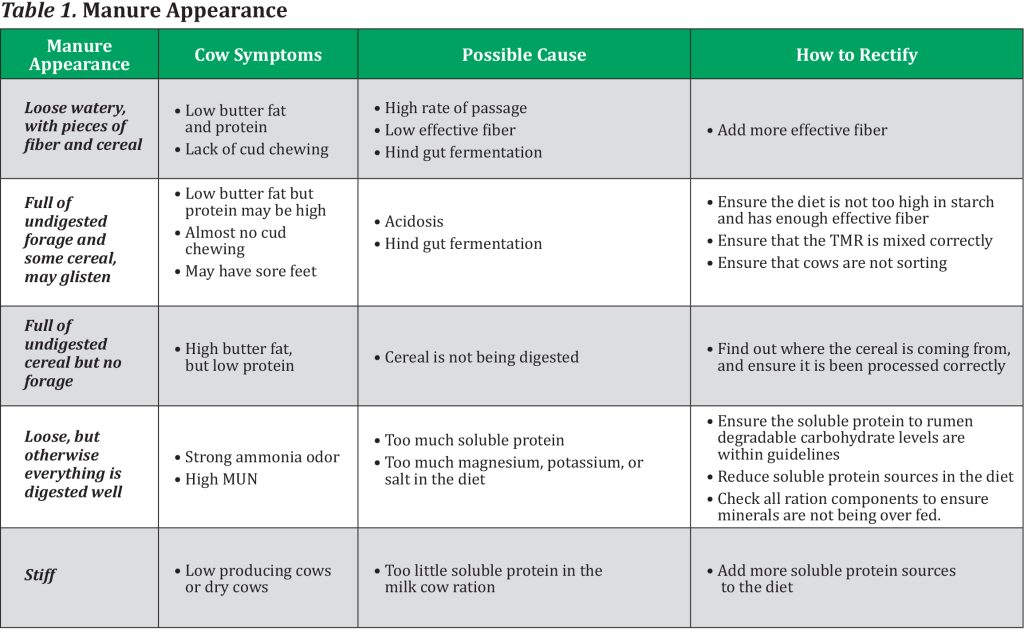
By Grace Thomas, M.Agr.Sc. P.A.S.
Consistency is the key when it comes to all things dairy. This is also relevant when it comes to cow manure. The cow manure evaluation is one of the best indicators of cow performance and any changes to it can be due to reduced rumen function and/or feed digestion.
You should note and investigate variations in cow manure to identify the cause. Then address and rectify any ration/dietary problems.
In order to comprehend how manure evaluation helps in determining how the cow is performing, we first need to understand how the digestive system works. The majority of the cow’s feed is fermented in the rumen. If the function of the rumen gets disrupted, it can lead to excess hindgut digestion. This fermentation in the hindgut causes a change in manure consistency such as foamy manure, diarrhea, and in worst cases, mucin casts.
A cow needs a minimum amount of fiber to maintain rumen function. This fiber is broken down by rumination (cudding) and rumen microbes. The microbes in the rumen rely on a stable pH to ensure efficient digestion. Fiber-digesting bacteria do not like a pH below 5.5. Any dietary issues such as slug feeding, sorting, or inadequate forage fed can cause the pH in the rumen to drop, resulting in reduced fiber digestion. In addition, if the cow does not get adequate fiber, feed will pass through the rumen quickly. This leads to larger particle size and poorly-digested feed in the manure. Cows that have a higher intake, like high-producing cows, may have more undigested feed in their manure. However, if cud chewing is inadequate (<60% of cows in the herd cudding) and manure is inconsistent, there may be another cause and this should be investigated.
You can do manure evaluation in two ways: looking at the pie/pat and looking at washed and sieved manure. Looking at the manure is a good place to start – it should be consistent across the herd. If there is variation larger than about 5% in the manure across the herd, it can mean the cows are not eating the same ration, either due to errors in TMR mixing, sorting by the cows, or spoiled feeds.

The manure of a dairy cow should have an appearance like porridge/oatmeal. It should stand 1-2 inches high, with rings and a ‘dimple’.
Dry cows and cows on higher forage intakes tend to have firmer manure. You should take this into account when looking at manure across a herd.
Disease or illness in the herd can be the cause of loose or inconsistent manure. If you can rule out dietary issues, please speak to your veterinary advisor to help identify the source.
Table 1 lists manure by appearance, cow symptoms, and possible dietary problems that can cause these issues.

Washing manure through a sieve/screen (6-8 squares to the inch) will give a more thorough assessment of how feed is being utilized.
You can assess any remaining grain in the sieve to see how well it is processed and if cows are utilizing the grain that is fed. Grains that are still whole or hard may suggest it needs additional processing/grinding before feeding or the grain is passing through the digestive tract too quickly. Any grain that still has some white starch remaining can indicate some feed values lost.
Undigested grain means the cow did not get the full nutrients from the diet provided. As the cow did not utilize the feed, lost milk and feed efficiency might result from this undigested grain.
As with the cow pie evaluation, you want consistent screened material across the herd.
The screened coarse fiber should be less than 0.5 inches long. Fibers over this length may be an indicator that either the forage is passing through the rumen too quickly. This can be caused by a forage chop that is too short to maintain the rumen mat and adequate cud chewing.
When you introduce new forages and feed into a diet, it is a good idea to observe the manure to ensure cows are performing efficiently on the new diet. The manure will help indicate any issues with the ration balancing. You can make changes to the diet based on the observations.
Agri-King’s enzyme products like Zy-Mend®, Ru-Max®, Maximiser®, Ru-Mend®, and Zym-O-Factors® aid the rumen and help the animal get more out of the feed that is fed. Manure screening after enzyme introduction is a good way of seeing how these products affect total feed digestion. Speak to your Agri-King representative today to see how they can help you formulate a balanced ration and get the most out of your animals. AK